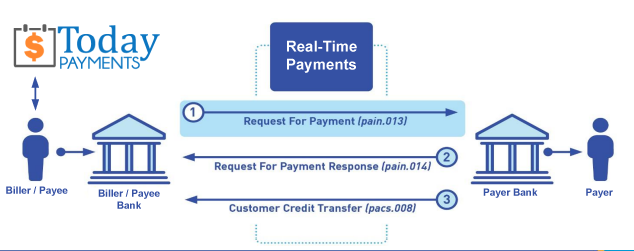
Recurring Payment Using Real-Time Payments with FedNow® or RTP® from Payer to Payee
To empower businesses to automate good-fund recurring payments using real-time Scheduled Request for Payments (RfPs) over FedNow® and RTP® rails, creating seamless, secure, and instant transactions from Payer to Payee without friction or delay.
TodayPayments.com is an ultimate recurring billing platform that turns Scheduled Requests for Payments into instant, good-fund transactions using FedNow® and RTP®. Whether through POS, MOTO, or ecommerce, our solution ensures merchants receive irrevocable payments in real time, while customers enjoy convenient, set-it-and-forget-it autopay—backed by standing authorization and modern A2A rails.
Scheduled Request for Payment (RfP™) with Standing Authorization
Traditional billing systems using ACH or credit cards often cause delays, failures, or reversals—leaving businesses chasing funds. In contrast, Recurring Payments using Real-Time Payment with FedNow® or RTP® enables scheduled RfPs where good-fund transactions move instantly from payer to payee.
By utilizing account-to-account (A2A) rails, businesses can schedule collections, eliminate chargebacks, and gain immediate access to funds—with zero manual payer intervention after initial setup. This is the foundation of real-time, automated, friction-free billing.
Scheduled RfPs allow merchants to collect funds at set intervals via FedNow® or RTP®, without having to wait for ACH windows or card settlement:
- One-time authorization by the payer = ongoing automated payments
- Every RfP is instantly fulfilled with good funds
- No returns, no rejections, no delays
- Full remittance data supports automatic reconciliation
This setup is ideal for C2B and B2B transactions like subscriptions, retainers, insurance, loan repayments, and memberships.
Recurring Invoice using digital Request for Payment for your business using Real-Time Payments
Recurring payments through RfP can be triggered across sales channels:
- POS: In-store subscriptions, equipment leasing, service plans
- MOTO: Call-in orders, recurring deliveries, catalog renewals
- eCommerce: SaaS platforms, digital products, monthly billing
Each RfP can be delivered by email, SMS, or hosted link, and confirmed in real time.
Itemized Real-Time Payment Attributes, Benefits & Features
|
Attribute |
Description |
|
Payment Type |
Real-Time A2A Debit via FedNow® or RTP® |
|
Request Mechanism |
Scheduled Request for Payment (RfP™) |
|
Settlement |
Instant, Irrevocable, Good Funds |
|
Customer Consent |
One-Time Standing Authorization |
|
Channels Supported |
POS, MOTO, Mobile, eCommerce |
|
Recurring Support |
Yes – Variable or Fixed Amounts |
|
Batch Initiation |
Yes – Bulk Recurring Billing with ISO 20022 Format |
|
User Experience |
“Set It and Forget It” Autopay via SMS, Email, QR Code, Hosted Page |
|
Security |
Alias-Based Authorization (Phone, Email), Bank-Encrypted Transfers |
|
Ideal Industries |
Insurance, Utilities, SaaS, Healthcare, Finance, Membership Services |
Ask us How:
- Automate recurring payments using FedNow® or RTP® by leveraging scheduled RfPs that trigger good-fund transactions from payer to payee in real time.
- Use standing authorization to enable automatic recurring billing for C2B and B2B models without requiring the payer’s approval each time.
- Replace delayed and reversible ACH or card payments with instant, irrevocable A2A transactions over RTP® and FedNow®.
- Set up recurring billing through POS, MOTO, or eCommerce, and ensure funds are deposited and usable immediately by the merchant.
- Enhance payment reliability with Request for Payments that include ISO 20022 structured remittance data for clean reconciliation.
- Perfect for subscription billing, insurance premiums, usage-based billing, and platform-as-a-service models where recurring cash flow is critical.
When creating a recurring invoice using a digital Request for Payment (RfP) and integrating it into Real-Time Payments services, several key elements come into play to ensure a seamless and efficient payment process. Here are the essential elements:
1. Payer and Payee Information: Collect accurate details about the payer and the payee, including their names, addresses, contact information, and any relevant identification numbers or account references. This information is necessary for initiating and processing payments through Real-Time Payments services.
2. Invoice Details: Capture all relevant invoice details, such as the invoice number, issue date, due date, payment terms, and any applicable discounts or late fees. These details help both parties understand the invoice requirements and payment expectations.
3. Itemized Charges: Itemize all goods or services provided in the recurring invoice, along with their corresponding quantities, unit prices, and total amounts. This itemization ensures transparency and accuracy in billing, allowing the payer to review the charges and reconcile them with the provided goods or services.
4. Payment Amount: Calculate the total amount due for the invoice, including any taxes, fees, or additional charges. Clearly indicate the currency in which the payment should be made to avoid confusion.
5. Payment Instructions: Provide clear instructions on how the payer can make the payment using Real-Time Payments services. Specify accepted payment methods (e.g., bank transfer, credit card, digital wallets), payment deadlines, and any required payment references or codes.
6. Recurring Payment Schedule: Define the recurring payment schedule, including the frequency (e.g., daily, weekly, monthly), start date, end date (if applicable), and the total number of recurring payments. This information ensures that both parties understand the payment schedule and expectations.
7. Authorization: Include language indicating that the payer authorizes the payee to initiate recurring payments according to the specified schedule. This authorization should be clear and explicit, outlining the terms and conditions of the recurring payment arrangement.
8. Terms and Conditions: Provide comprehensive terms and conditions governing the recurring payment arrangement, including cancellation policies, late payment penalties, dispute resolution procedures, and any other relevant terms. This ensures that both parties are aware of their rights and obligations regarding recurring payments.
9. Compliance and Security: Ensure compliance with all applicable legal and regulatory requirements, including data privacy laws, financial regulations, and industry standards. Implement robust security measures to protect sensitive financial information and prevent unauthorized access or fraud.
10. Error Handling and Dispute Resolution: Establish effective mechanisms for error handling and dispute resolution to address any issues that may arise during payment processing. Provide avenues for payers to report errors or disputes and facilitate prompt resolution.
By incorporating these elements into the integration between a digital Request for Payment and Real-Time Payments services for creating recurring invoices, businesses can streamline payment processes, improve cash flow management, and enhance overall efficiency in managing recurring payments.
Real-Time Autopay that Moves Good Funds — Only at TodayPayments.com
Recurring payments shouldn't be slow, uncertain, or manually approved. With TodayPayments.com, businesses gain the power to automate good-fund recurring payments using real-time RTP® and FedNow® rails, from payer to payee.
Imagine collecting payments without worrying about chargebacks, processing delays, or payer action. With standing authorization, RfPs are scheduled and fulfilled like clockwork—delivering good funds instantly, with full transparency and total control.
👉 Ready to automate recurring billing with real-time payments? Visit https://www.TodayPayments.com and start collecting irrevocable payments—in full, on time, and every time.
Creation Request for Payment Bank File
Call us, the .csv and or .xml Real-Time Payments (RTP) or Request for Payment (RfP) file you need while on your 1st phone call! We guarantee our reports work to your Bank and Credit Union. We were years ahead of competitors recognizing the benefits of RequestForPayment.com. We are not a Bank. Our function as a role as an "Accounting System" in Open Banking with Real-Time Payments to work with Billers to create the Request for Payment to upload the Biller's Bank online platform. U.S. Companies need help to learn the RfP message delivering their bank. Today Payments' ISO 20022 Payment Initiation (PAIN .013) shows how to implement Create Real-Time Payments Request for Payment File up front delivering a message from the Creditor (Payee) to it's bank. Most banks (FIs) will deliver the message Import and Batch files for their company depositors for both FedNow and Real-Time Payments (RtP). Once uploaded correctly, the Creditor's (Payee's) bank continues through a "Payment Hub", will be the RtP Hub will be The Clearing House, with messaging to the Debtor's (Payer's) bank.

... easily create Real-Time Payments RfP files. No risk. Test with your bank and delete "test" files before APPROVAL on your Bank's Online Payments Platform.
Today Payments is a leader in the evolution of immediate payments. We were years ahead of competitors recognizing the benefits of Same-Day ACH
and Real-Time Payments funding. Our business clients receive faster
availability of funds on deposited items and instant notification of
items presented for deposit all based on real-time activity.
Dedicated to providing superior customer service and
industry-leading technology.

Each day, thousands of businesses around the country are turning their transactions into profit with real-time payment solutions like ours.
Contact Us for Request For Payment payment processing

